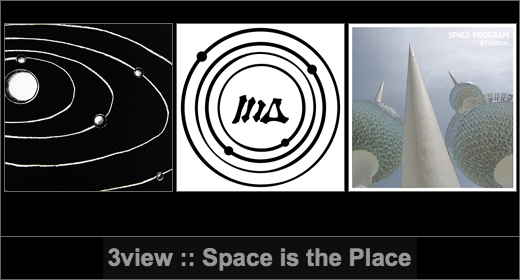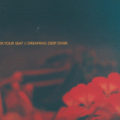Electronic music is so much more down to earth these days, and that is a good thing. But when it first emerged, it was inextricably associated with the technology that made it possible and the future that technology would create for us beyond the selfish pull of gravity. It almost feels like that upon hearing its first tones, science fiction movies and the NASA space program were invented in order to give them a proper context. Luckily, man will always reach for the stars and here are three very different but equally enjoyable recent attempts.
:: :: ::
Contemporary Vision :: Solar (Contemporary Vision)—First of all, great name. It immediately encapsulates the forward-looking, seventies sound of optimal pleasures awaiting in the near future in which Solar trades. Even the brevity of its four tracks—”Solar,” “Lunar,” “Stellar” and “Nebular”—three to four minutes each—the stylized, angular Contemporary Vision logo, and its website all evince a confident, effective professionalism. The future is in caring, corporate hands. Solar is the piano bar in the first-class lounge of the space port, where passangers while away the time before ascending the space escalator to the new moon spa. Contemporary Vision’s beats are countersunk to keep the surface slippery, streamlined with the melody. Not too futuristic because people in the seventies wanted their future utopian but familiar, a magnificently rationalized and pleasure-centred fifties, not complex and digitalized and soylent green is people! Perfect, reassuring music for thumbing through a catalogue of new time-saving products and luxury items available for purchase on board.
:: :: ::
Michael Amason :: The Inner Solar System (Cookies N’ Cream)—Michael Amason’s double CD The Inner Solar System hearkens back to one of the first orchestral pieces to become a popular hit in its electronic interpretation, Gustav Holst’s The Planets (1914-16) by Tomita. It too is symphonic but in a far less dramatic and far more suggestive form. While Holst attempted to capture the astrological influences each planet was said to exercise, and pits various states against one another for colour and effect (war and peace, motion and statis), Amason slowly describes the orbits of the four planets nearest to the sun, Mercury, Venus, Earth and Mars. Even though he might be considered proto-ambient with his strong influence from Ravel and Hinduism, Holst’s work is brash, virtuostic and modernist, while Amason is a postmodern ambient minimalist who moves the listener through restraint and duration. Waves of slowed and processed guitar drone on, once with a certain sweetness recalling the French horn, another time a sustained, monotonous thrum, a lone note from a piano tumbling off like an asteroid. Rather than influencing our lives, Amason reminds us of the vast emptiness and lonely indifference of the space through which the planets travel, underlined by the absences he ascribes each one—no light, no love, no God (that’s Earth) and no pain. Long after we have gone, unaware that we were ever here, they will remain, describing their circles. Amason’s drones allow us to ponder that a while.
:: :: ::
Space Program :: Æthereal (self-released)—This is only the second release by Space Program, launched by CR Hougaard from Denmark in 2009. With guitars, synthsizers and effects run through an old tape recorder, he takes us to the dark side of the moon, to a place where things go wrong. Æthereal was inspired by the real-life story of the Judica-Cordiglia brothers, Italian radio amateurs who claimed to have recorded secret Soviet space program transmissions at the height of the Cold War, including the messages of doomed cosmonauts. The sound of Space Program is the polar opposite of the reassuring Contemporary Vision, lopsided and distressed, still experimenting, at times pushing the technology too far and failing. It is the space of paranoia, weird science and the Astounding Stories’ fifties and sixties, whose charm Hougaard explicitly prizes. Although it opens triumphantly, “Liftoff” becomes increasingly harrowing over its fifteen minutes. A dark, searching approach is taken on the track named after Konstantin Tsiolkovsky, an odd, hermetic philosopher considered a pioneer of space travel theory. However, the closing track “Pacific” conveys the weightless wonder and panoramic view that is the fascination of space travel in the first place.
:: :: ::
All three aforementioned releases are out now.



















![Hasbeen :: Bunker Symphonies II (Clean Error) — [concise]](https://igloomag.com/wp/wp-content/uploads/2025/04/hasbeen-bunker-symphonies-ii_feat-75x75.jpg)
![Extrawelt :: AE-13 (Adepta Editions) — [concise]](https://igloomag.com/wp/wp-content/uploads/2025/04/extrawelt-ae-13_v_feat-75x75.jpg)
![Beyond the Black Hole :: Protonic Flux EP (Nebleena) — [concise]](https://igloomag.com/wp/wp-content/uploads/2025/04/beyond-the-black-hole-protonic-flux_feat-75x75.jpg)
![H. Ruine, Mikhail Kireev :: Imagined / Awakenings (Mestnost) — [concise]](https://igloomag.com/wp/wp-content/uploads/2025/04/h-ruine-mikhail-kireev-imagined-awakenings_feat2-75x75.jpg)


![Squaric :: 808 [Remixes] (Diffuse Reality) — [concise]](https://igloomag.com/wp/wp-content/uploads/2025/04/squaric-808-remixes_feat-75x75.jpg)

